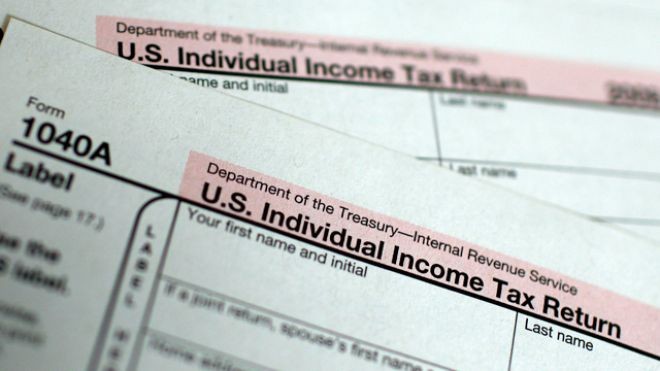Picking The Proper 1040 Tax Return Form
Post on: 16 Март, 2015 No Comment

By Kay Bell • Bankrate.com
Taxes » Tax Forms » Picking The Proper 1040 Tax Return Form
Most people hate filling out tax forms almost as much as they hate forking over dough to Uncle Sam. That’s why you should use the simplest tax return form you can, especially if you’re still filling out your forms by hand.
But choose carefully. While all the personal income tax forms — 1040, 1040A and 1040EZ — are designed to get the appropriate amount of your money to the IRS, the differences in these returns could cost you if you’re not paying attention.
The EZ is the shortest and simplest form, Form 1040A is a bit more complex and the long Form 1040 is the most detailed and potentially difficult. But even though your tax life is simple and straightforward, it might be worthwhile to investigate the other two forms. Why? Generally, the longer the form, the more opportunities for tax breaks.
Health care and EZ limits
Beginning with the 2015 filing season, some individuals who previously filed Form 1040-EZ won’t be able to use the shortest form to file their taxes. This applies to folks who bought Affordable Care Act-required health insurance through a state or federal exchange, also known as the marketplace.
An option upon policy purchase was to receive advance payment of the premium tax credit. This tax credit helps cover some of the insurance costs. The advance credit amount, however, must be accounted for when the policy recipient files his or her tax return.
If the advance premium amount was too small, the taxpayer will get the extra. However, if too large of an advance premium credit was paid, the taxpayer must make up the difference, either by paying any tax due or by having the amount taken from an expected refund.
Such calculations are made on Form 8962, which only can be filed with Form 1040A or 1040. If you received advance payments of the premium tax credit, you must file one of these longer forms instead of the 1040EZ.
If you did not get the premium credit in advance but got health care through an exchange and want to claim it when you file, you must complete 1040A or 1040.
How the EZ could cost you
Even if you can file 1040EZ, it might not be the best move.
Take the case of 2014 tax filer Joe P. Taxpayer. Joe finished college last year and got his first full-time job making $40,000. He’s single, renting and has no investment income. A perfect 1040EZ filer, right? Sure, if you’re Uncle Sam, because Joe will overpay his taxes by using the short form.
More On Taxes:
taxes
Why? The Form 1040EZ doesn’t offer Joe some valuable tax breaks found on the other two returns.
Joe has a student loan. By filing Form 1040A, he can subtract from his income the $2,500 interest he paid on that debt. He can’t do that with the shortest form. Joe also started planning for his retirement by putting $5,000 into a traditional individual retirement account. Because his new employer doesn’t offer a company retirement plan, Joe’s deductible IRA contribution can reduce his taxable income further, but only if he files the longer form.
By choosing the 1040A over the 1040EZ, suddenly Joe owes taxes on just $32,500 instead of on his full $40,000 salary. And he’s dropped into a lower tax bracket — the 15 percent one instead of the 25 percent tier — even before he reduces his taxable income further by taking the personal exemption that every taxpayer is allowed and his standard deduction amount.
Joe also would get the chance to reduce his actual bill if he files the longer 1040A. If Joe took a course to improve his job skills and was not reimbursed by his employer for the cost, he could claim the Lifetime Learning tax credit; it’s also available on the long Form 1040. The better tax news for Joe is that a credit allows you a dollar-for-dollar reduction of what you owe the IRS. But the only tax credit available on the 1040EZ is the earned income tax credit, available only to low-income taxpayers.
So, opting to file Form 1040A instead of 1040EZ saves Joe a bundle. And there are even more tax-saving opportunities found on the long Form 1040. They might not apply to Joe, but they could cut your tax bill — if you take the time to look over each of the forms. Here are the basic guidelines for the three individual tax returns.
Form 1040EZ
The simplest IRS form is the Form 1040EZ. And ever since the IRS doubled the earning limit on filers who use it, the EZ has been available to even more taxpayers.
You can file the 1040EZ return if:
- Your filing status is single or married filing jointly.
- You’re younger than 65. Your spouse also must meet the age requirements if you file a joint return. If you or your spouse’s 65th birthday is Jan. 1, then for filing purposes you are considered to have turned 65 last year and therefore cannot file this form.
- You (or your spouse if filing jointly) were not legally blind during the last tax year.
- You have no dependents.
- Your interest income is less than $1,500.
- Your income, or combined incomes for joint filers, is less than $100,000.
The ease of the one-page 1040EZ is appealing, but it limits the number of ways to save on your tax bill.
As already mentioned, this shortest personal return restricts filers to claiming just one credit: the earned income tax credit, or EITC, a tax break designed to help out individuals who don’t make much money.
You also need to look at those other two individual tax returns to take advantage of additional income adjustments and tax credits.














